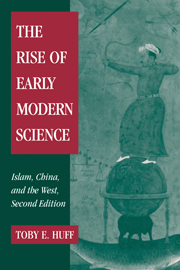Book contents
- Frontmatter
- Dedication
- Contents
- List of illustrations
- Preface to the second edition
- Preface to the first edition
- Acknowledgments
- Introduction
- 1 The comparative study of science
- 2 Arabic science and the Islamic world
- 3 Reason and rationality in Islam and the West
- 4 The European legal revolution
- 5 Madrasas, universities, and science
- 6 Cultural climates and the ethos of science
- 7 Science and civilization in China
- 8 Science and social organization in China
- 9 The rise of early modern science
- Epilogue: educational reform and attitudes toward science in the Muslim world and China since the eighteenth century
- Selected bibliography
- Index
8 - Science and social organization in China
Published online by Cambridge University Press: 05 June 2016
- Frontmatter
- Dedication
- Contents
- List of illustrations
- Preface to the second edition
- Preface to the first edition
- Acknowledgments
- Introduction
- 1 The comparative study of science
- 2 Arabic science and the Islamic world
- 3 Reason and rationality in Islam and the West
- 4 The European legal revolution
- 5 Madrasas, universities, and science
- 6 Cultural climates and the ethos of science
- 7 Science and civilization in China
- 8 Science and social organization in China
- 9 The rise of early modern science
- Epilogue: educational reform and attitudes toward science in the Muslim world and China since the eighteenth century
- Selected bibliography
- Index
Summary
We saw in the preceding chapter and earlier that from about the eighth to the fourteenth century, the Arabs had the most advanced science in the world. Consequently, in the fields of astronomy, mathematics, optics, and physical experimentation – which led directly to modern science – Chinese science was second to that of the Arab-Islamic world. Present scholarship regarding Chinese science suggests, moreover, that China developed along lines quite independent of the West and the Arabic Middle East. The Chinese knew nothing of Aristotle, Euclid, Ptolemy, or Galen. Nevertheless, there were areas in which the Chinese did accomplish great things, though in almost no case was there continuous and progressive development.
As we saw in Chapter 2, discussions can be found in the writings of Chinese mathematicians on arithmetic fractions, the statement of formulas for the computation of areas and volumes, the solution to systems of simultaneous equations, and procedures for square and cube extraction. These are to be found in The Nine Chapters on the Mathematical Procedures (from about the first century). During the Sung dynasty (ca. 960–1279) Chinese mathematics underwent another period of creative growth, especially in algebraic computation. It is said that “a general technique was found for the solution of numerical equations containing any power of a single unknown.” However, it has also been claimed that the Chinese system of representation and positional notation, as well as its techniques of computation (with counting rods), were cumbersome and not nearly as generalizable and easy to use as the Arabic-Hindu numeral system. These Arabic-Hindu numerals, located in a decimal place value system had been available in al-Khwarizmi's work since about 825. In contrast, the course of development of mathematics in China required a move from computation with counting rods to the use of the abacus (generally in about the sixteenth century) and the incorporation and use of the zero (in the thirteenth and fourteenth centuries). Only in the seventeenth century was the method of paper-and-pen calculation (and hence recorded arithmetic operations) introduced into mathematics with the arrival of the Jesuits.
- Type
- Chapter
- Information
- The Rise of Early Modern ScienceIslam, China and the West, pp. 289 - 324Publisher: Cambridge University PressPrint publication year: 2003



